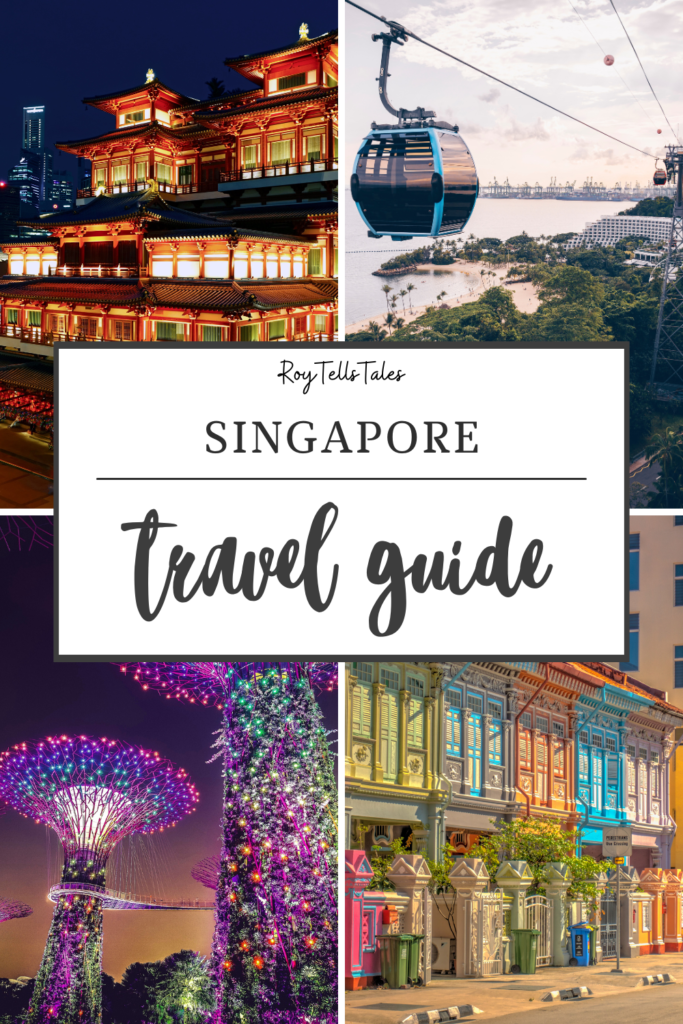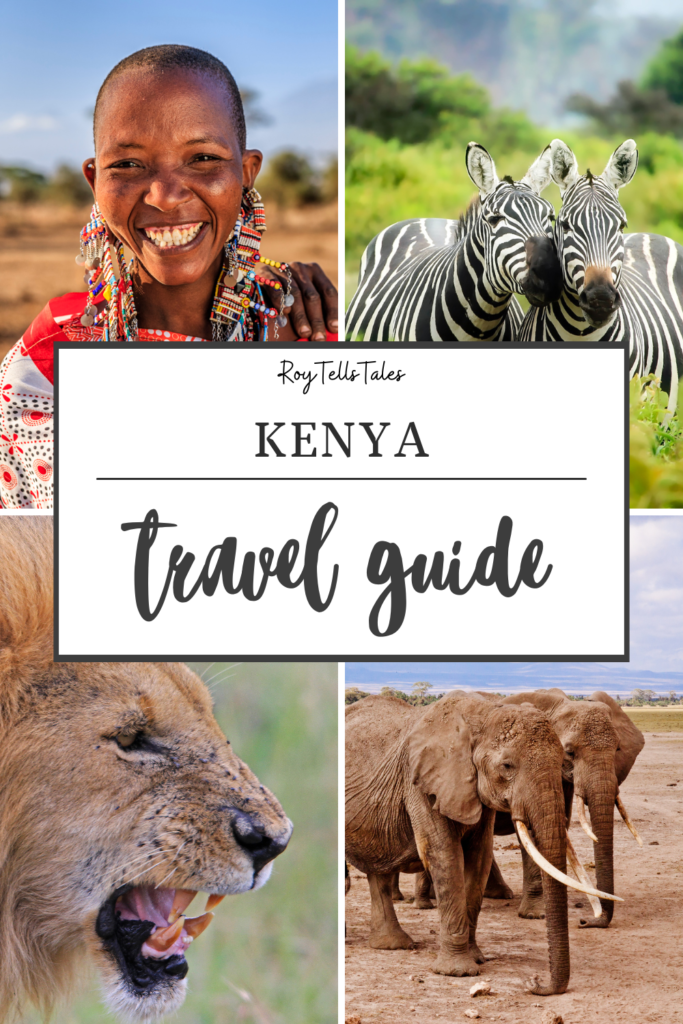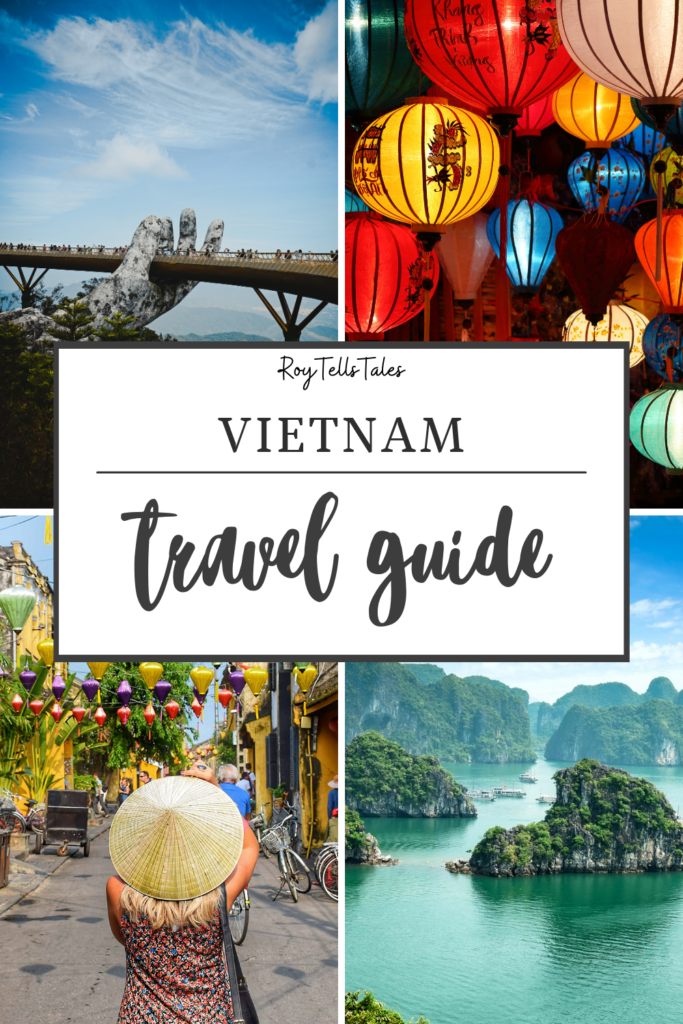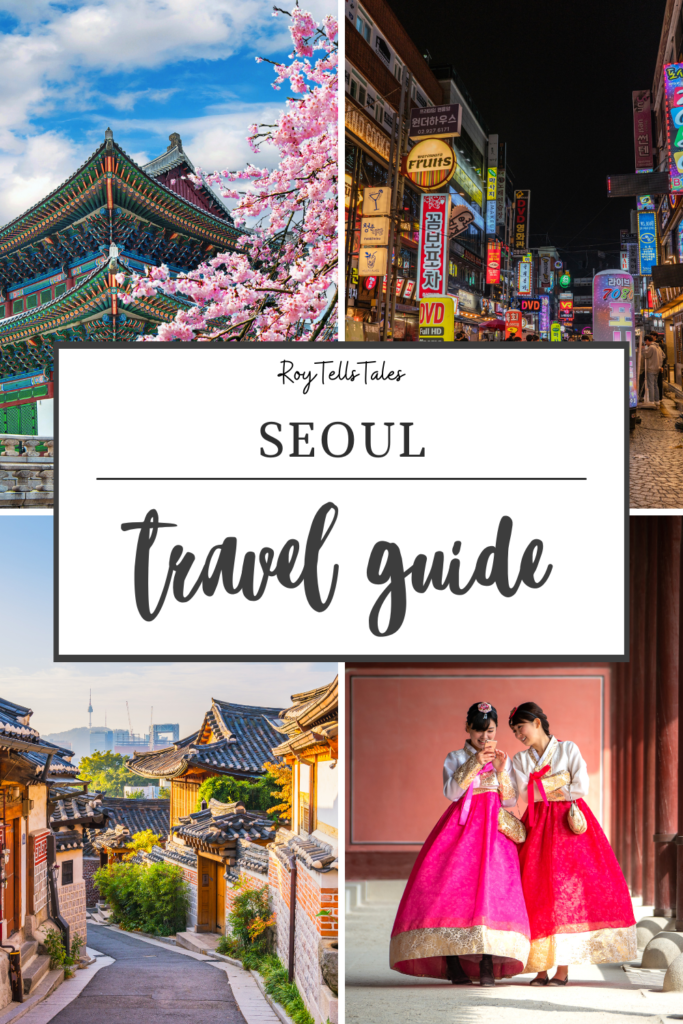

8 Days in Vietnam Itinerary: The Ultimate Travel Guide
Planning a trip and wondering how to make the most of 8 days in Vietnam? I have been lucky enough to visit this beautiful country three times, and every visit has shown me something new and unforgettable. From the bustling streets of Hanoi to the magical limestone cliffs of Ha Long Bay, Vietnam is a place that never fails to amaze me. This 8-day itinerary in Vietnam is designed to give you a perfect balance of culture, history, nature, and relaxation.
In just over a week, you will discover the charm of Hanoi’s Old Quarter, cruise through the emerald waters of Ha Long Bay, and explore the hidden beauty of Ninh Binh, often referred to as “Ha Long Bay on land.” You will then fly south to the central coast, where the lantern-lit streets of Hoi An await you, along with golden beaches and unforgettable sunsets. The itinerary also includes Da Nang, where you can spend a day at the magical Ba Na Hills, walk across the famous Golden Bridge, explore the Marble Mountains, and visit the towering Lady Buddha statue overlooking the sea.
If you are visiting Vietnam for the first time, this itinerary will show you all the highlights that should not be missed. And if you have already been here before, like me, you will still find something fresh and inspiring with every trip.
This guide will walk you through each day in detail, so you can plan your own unforgettable journey through Vietnam in 8 days.
Day 1: Arrival in Hanoi & Exploring the Old Quarter
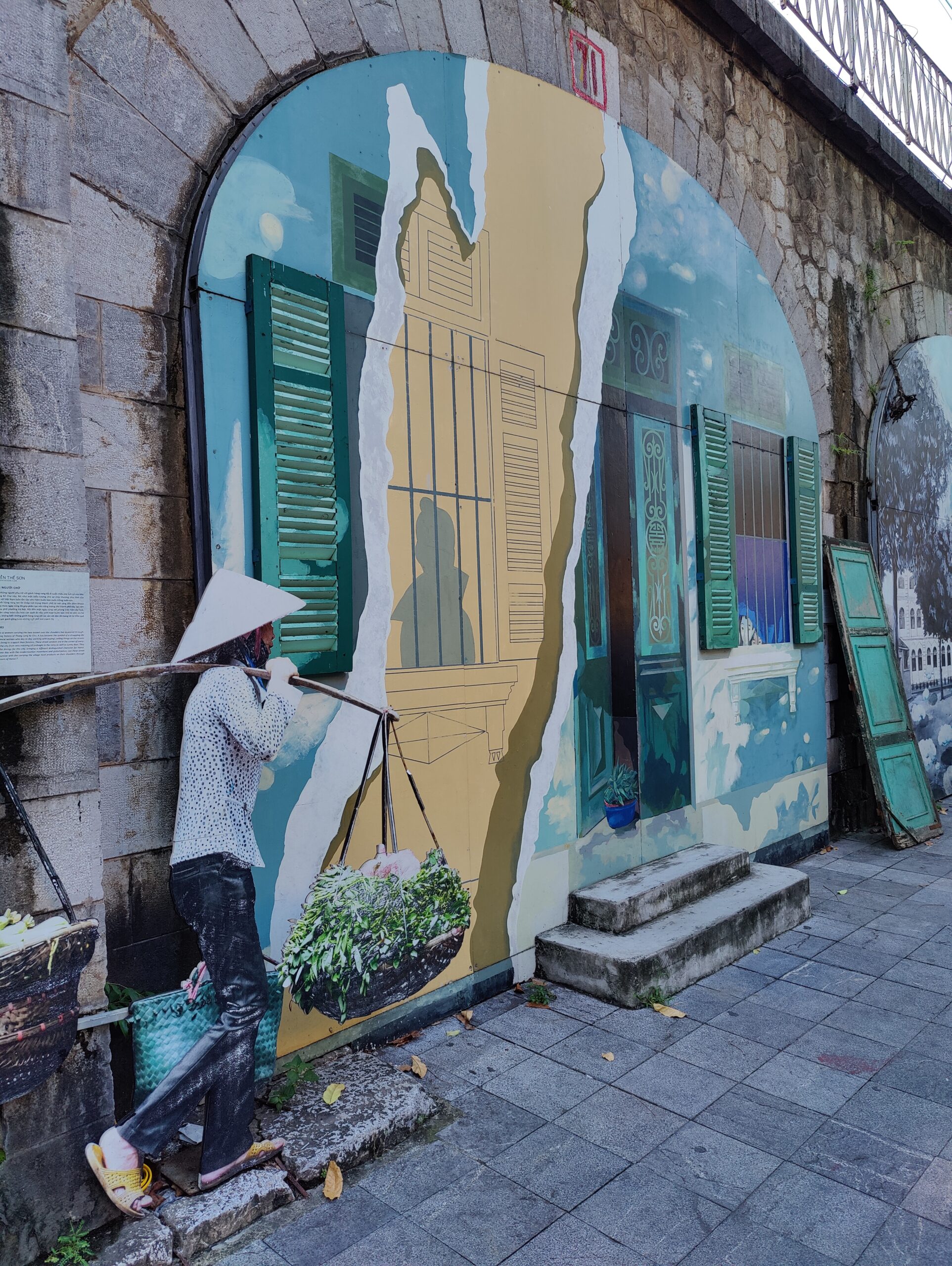
Morning / Afternoon: Arrival and Check-in
Arrive at Noi Bai International Airport in Hanoi. After immigration and baggage collection, take a private transfer or airport taxi to your hotel in the city. Depending on where you stay, it usually takes around 40–50 minutes to reach the Old Quarter area. Once you check in, take a few hours to settle in and rest. If you arrive early, you might want to freshen up and grab a light snack before heading out.
Tip: I would recommend staying close to the Old Quarter or near the Hoen Kiem Lake.
Afternoon: Hoan Kiem Lake & Ngoc Son Temple
Start your Vietnam adventure with a leisurely walk around Hoan Kiem Lake, the most iconic spot in Hanoi. This peaceful lake sits right in the middle of the bustling city and is a favourite gathering place for locals, especially in the mornings when people practice tai chi. Take a moment to cross the bright red Huc Bridge, which leads to Ngoc Son Temple, a small temple located on an island in the lake. It’s a great introduction to Vietnamese culture and legends, especially the story of the giant turtle that once lived in the lake.
For lunch, you can head to Hanoi Social Club or Bancong – both offer delicious local meals. Hanoi Social Club also has great vegetarian options.
Evening: Hanoi Old Quarter Experience
As the sun sets, head into the Old Quarter, a maze of narrow streets named after the trades that used to dominate them—like Silver Street, Silk Street, and Paper Street. Here you’ll find a lively mix of shops, street vendors, and colonial-era architecture. The Old Quarter is also the perfect place to experience Hanoi’s famous street food culture. You can either join a guided food tour or wander on your own, stopping to taste local specialities. You can also take a walk around the Hanoi Mural Street.
Make sure to watch a Vietnamese Water Puppet Show, an art form that dates back to the 11th century. The performance tells traditional folk stories through colourful puppets gliding across the water, accompanied by live music and singing. It’s entertaining, unique, and a must-see while in Hanoi.
Dinner: Local Vietnamese Dishes
For dinner, try authentic Hanoi flavours. A steaming bowl of pho (Vietnam’s most famous noodle soup) is always a good choice. If you want something more filling, order bun cha, a dish of grilled pork served with rice noodles and fresh herbs, which is famously loved by Anthony Bourdain and Barack Obama during their visits. Another must-try is the Vietnamese banh mi, a crispy baguette sandwich filled with meats, pickled vegetables, and herbs.
For banh mi, you can go to Banh Mi 25, and if you want to have pizzas, I’d definitely recommend going to Pizza 4Ps.
Optional Nightlife: Ta Hien Street
If you still have energy after dinner, explore Hanoi’s lively nightlife. Head to Ta Hien Street, often called “Beer Street,” where locals and travellers sit on small plastic stools sipping bia hoi (fresh draft beer) and enjoying the buzzing atmosphere. You’ll also find live music bars and nightclubs if you’re in the mood for something more upbeat. Hanoi’s nightlife is vibrant yet laid-back, making it a perfect way to end your first night in Vietnam.
Day 2: Day Trip to Ha Long Bay
On the second day of your 8-day itinerary in Vietnam, prepare for one of the most breathtaking highlights of the trip: Ha Long Bay, a UNESCO World Heritage Site and one of the ‘New Seven Wonders of the World’. With its emerald-green waters and over 1,600 limestone islands and islets rising dramatically from the sea, Ha Long Bay is truly magical.
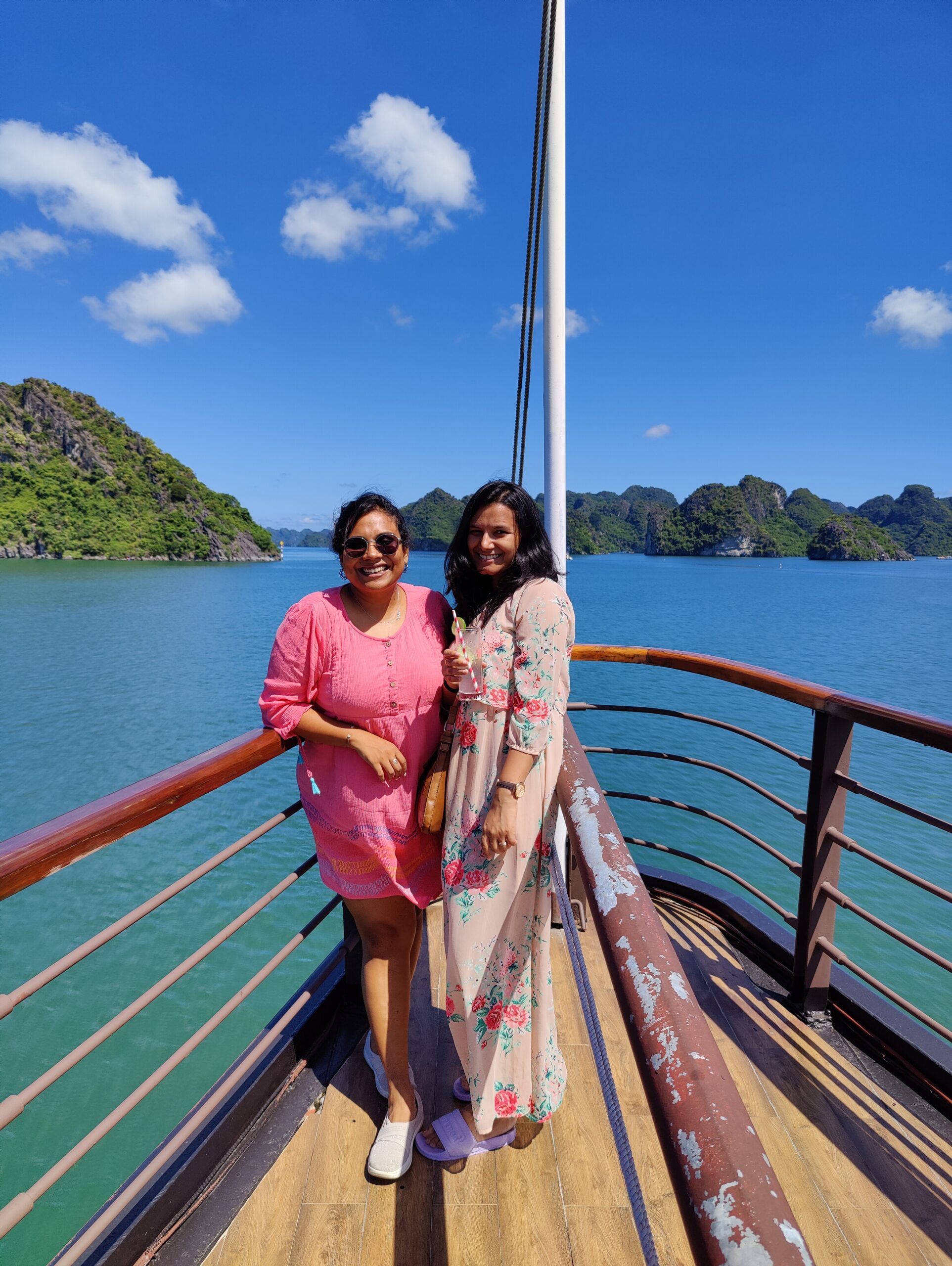
Morning: Scenic Drive from Hanoi to Ha Long
After an early breakfast at your hotel, set out on a 3 to 4-hour drive from Hanoi to Ha Long Bay. The journey takes you through Vietnam’s rural countryside, with endless rice paddies, small villages, and glimpses of local life. If you’re travelling by a private car or shuttle bus, sit by the window to soak in the views. Some tours also make a quick stop halfway for refreshments or to visit a handicraft centre.
Midday: Boarding the Cruise
Upon arrival at the pier, board your Ha Long Bay day cruise. Most cruises are spacious with indoor dining areas, outdoor decks, and lounging spaces so you can comfortably enjoy the scenery. As the boat sets sail, prepare to be mesmerised by the sight of towering limestone cliffs, lush green islands, and fishing villages floating on the water.
Activities in Ha Long Bay
Your cruise will typically include a mix of sightseeing, relaxation, and soft adventure activities. Here’s what you can expect:
Seafood Lunch on Board: Enjoy a freshly prepared Vietnamese seafood lunch as the boat sails deeper into the bay. Expect dishes like prawns, fish, squid, and stir-fried vegetables. Vegetarian options are usually available if requested in advance.
Kayaking Adventure: Paddle your way through hidden lagoons and narrow caves surrounded by limestone cliffs. Kayaking is the best way to experience the bay’s serenity up close. If you prefer not to kayak, some tours offer bamboo boat rides rowed by locals.
Cave Exploration: Depending on your cruise, you may stop to explore one of Ha Long Bay’s famous caves, such as Sung Sot (Surprise Cave) or Thien Cung (Heavenly Palace Cave). These caves are filled with fascinating stalactite formations and hidden chambers.
Relax on the Deck: Between activities, take time to relax on the sun deck. It’s the perfect spot for photography or simply soaking up the views as the limestone peaks pass by.
Evening: Return to Hanoi
After an afternoon of exploring, the boat returns to the pier. From there, drive back to Hanoi, reaching the city by evening. You can enjoy dinner at a local restaurant, perhaps trying something different from Day 1, like grilled fish (cha ca) or hotpot.
Travel Tip: Overnight Cruise Option
While a day trip to Ha Long Bay gives you a wonderful taste of its beauty, staying overnight on a cruise is an unforgettable experience. You’ll get to see the bay at sunrise and sunset, enjoy evening activities like squid fishing, and wake up surrounded by misty limestone cliffs. If your schedule allows, consider extending your Ha Long Bay trip to 2 days and 1 night.
Day 3: Day Trip to Ninh Binh – Vietnam’s Hidden Gem
Your third day in this 8-day itinerary in Vietnam takes you to Ninh Binh, a destination often referred to as “Ha Long Bay on land.” Just a short two-hour drive south of Hanoi, Ninh Binh offers dramatic limestone karsts, lush rice paddies, ancient temples, and tranquil waterways. It is less crowded than Ha Long Bay but equally stunning, making it one of the best hidden gems in Vietnam.
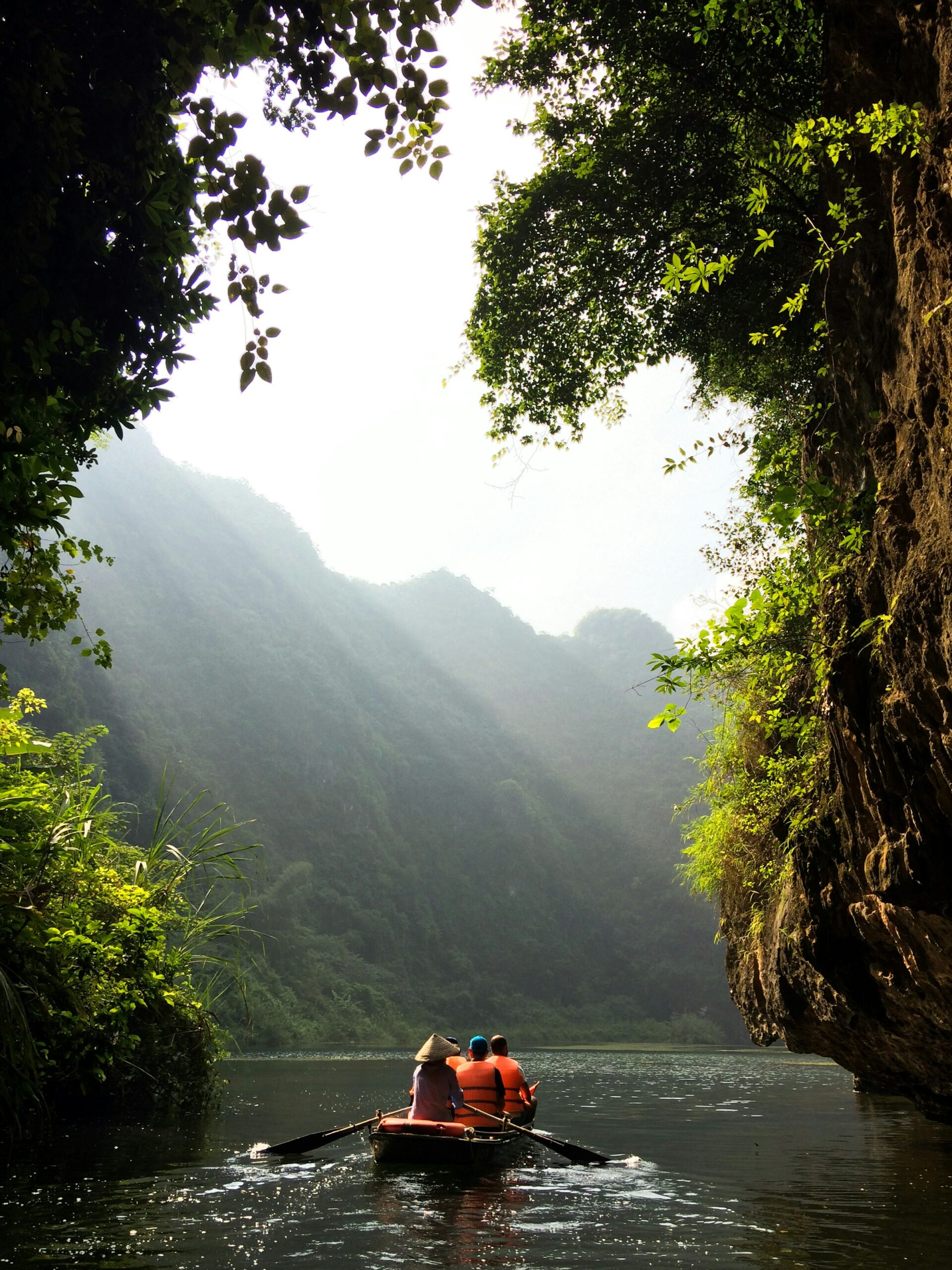
Morning: Journey to Ninh Binh
After breakfast, depart from Hanoi by car or bus. The drive takes around two hours, and along the way you will pass small villages and endless rice fields. It is a peaceful contrast to the busy capital, and you will soon see why Ninh Binh is loved by travellers seeking nature and quiet landscapes.
Highlights in Ninh Binh
Boat Ride in Tam Coc or Trang An
Start your visit with a traditional sampan boat ride in either Tam Coc or Trang An, both of which are famous for their stunning waterways surrounded by towering limestone cliffs. Tam Coc is often referred to as the “Three Caves” route, where you glide through caves and past rice paddies. Trang An, on the other hand, offers a network of grottoes, lakes, and temples. Both options are equally beautiful and give you a chance to see Ninh Binh’s landscapes up close.Hoa Lu Ancient Capital
Next, visit Hoa Lu, the former capital of Vietnam during the 10th and 11th centuries. This historic site is home to ancient temples dedicated to Emperor Dinh Tien Hoang and Emperor Le Dai Hanh. While the structures are relatively modest, the setting against limestone hills makes it a fascinating stop for history and culture lovers.Mua Cave Viewpoint
End your sightseeing in Ninh Binh with a climb to the top of the Mua Cave Viewpoint. The hike takes about 20 to 30 minutes up nearly 500 stone steps, but the reward is worth the effort. From the summit, you will enjoy breathtaking panoramic views of Tam Coc’s rice fields, rivers, and limestone mountains. It is one of the most photographed spots in Ninh Binh and best visited in the late afternoon when the light is softer.
Evening: Return to Hanoi
After a day of exploring Ninh Binh’s natural beauty and historic sites, drive back to Hanoi in the evening. You can have dinner at one of the city’s many local restaurants. For a different taste, try dishes such as bun rieu (crab noodle soup) or nem ran (Vietnamese fried spring rolls).
You can head to Tam Vi in Hanoi (a Michelin-star restaurant) and try their delicious menu.
Day 4: Fly to Da Nang and Sunset in Hoi An
It’s time to explore Central Vietnam, and what better than Hoi An and Da Nang?
Morning: Flight from Hanoi to Da Nang
After breakfast, head to Hanoi’s Noi Bai International Airport for a short domestic flight to Da Nang. The flight takes about one and a half hours, so you will still have plenty of time to enjoy your day. Once you land in Da Nang, it is an easy 45-minute transfer by car to Hoi An. The drive takes you past coastal roads and rice fields, giving you a first glimpse of the region’s laid-back atmosphere.
Afternoon: Settle in at Your Hotel
Arrive in Hoi An around midday and check into your hotel. Depending on your choice of stay, you could be in the heart of the Ancient Town or near the beach. Take some time to relax, unpack, and soak in the slower pace of Hoi An compared to the busy atmosphere of Hanoi. A light lunch or a short rest will prepare you for an enchanting evening ahead.
Evening: Sunset and Ancient Town Magic
Sunset at the Beach
Begin your evening by heading to An Bang Beach or Cua Dai Beach. Both beaches are wide, sandy, and perfect for watching the sun dip below the horizon. An Bang is livelier with beachside cafes and bars, while Cua Dai offers a quieter and more serene setting. Whichever you choose, the sunset views are spectacular. I would definitely recommend visiting this cafe, called ‘Sound of Silence’, which has a gorgeous beach just next to it! So you can sip your coconut coffee and watch the sunset.Explore Hoi An Ancient Town
After sunset, make your way to Hoi An Ancient Town, a UNESCO World Heritage Site. The town is famous for its beautifully preserved architecture, with wooden merchant houses, colourful lanterns, and narrow streets that tell stories of its trading past. Do not miss the Japanese Covered Bridge, one of the most iconic landmarks of Hoi An. Strolling through the lantern-lit streets at night feels like stepping back in time.
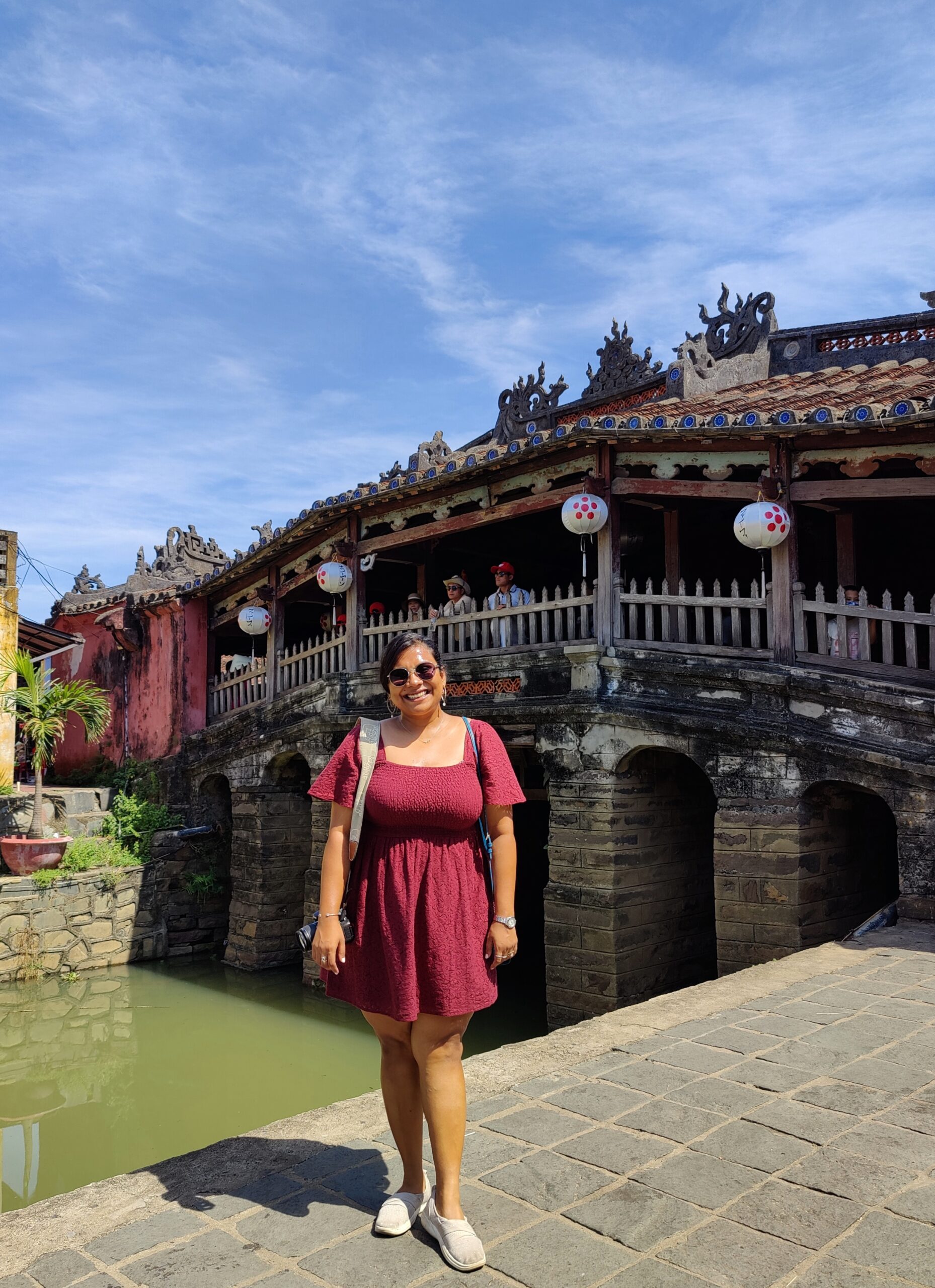
Lantern Boat Ride on Thu Bon River
One of the most magical experiences in Hoi An is taking a boat ride on the Thu Bon River at night. As you float on the water, you will see hundreds of glowing lanterns drifting downstream, creating a scene that feels straight out of a dream. It is romantic, peaceful, and one of the highlights of visiting Hoi An.Dinner at one of the many riverside restaurants
End the evening with dinner at one of Hoi An’s riverside restaurants. Many offer both Vietnamese specialities and international dishes, but it is best to try local favourites like cao lau, white rose dumplings, or mi quang. Dining with the view of the river, the glowing lanterns, and the soft buzz of the town is the perfect way to wrap up your first day in Hoi An.
Day 5: Discover Hoi An’s Culture, Food and Charm
Hoi An is one of those places where time seems to slow down. The colourful lanterns, riverside cafés, tailor shops, and the aroma of fresh street food create a setting that feels magical. Make the most of your day and immerse yourself in the culture, food, and charm of this UNESCO World Heritage town.
[Also Read: Coffee culture in Vietnam: A journey beyond the beans]

Morning: Vietnamese Coffee Workshop
Start your day with a Vietnamese coffee-making workshop, a must-do in Hoi An. Vietnam is the second-largest coffee producer in the world, and coffee here is more than just a drink; it is a culture in itself. During the workshop, you will learn different brewing styles such as drip filter (phin), iced milk coffee (ca phe sua da), salt coffee, and even the famous egg coffee. Each style has its own unique taste, and by the end of the session, you will appreciate just how special Vietnamese coffee really is.
Late Morning: Walking Tour of Hoi An Ancient Town
After your caffeine fix, join a guided walking tour of Hoi An Ancient Town. This is the best way to truly understand the town’s history and architecture. Some highlights include:
Tan Ky House: A 200-year-old merchant’s house blending Chinese, Japanese, and Vietnamese architectural styles.
Assembly Halls: Ornate temples built by Chinese trading communities, each with striking gates and intricate carvings.
Hoi An Market: A vibrant hub where locals sell fresh produce, spices, and a variety of street food. It is also a great place to try authentic snacks on the go.
Walking through the streets, you will notice the perfect mix of old-world charm and vibrant local life.
Lunch: Authentic Hoi An Dishes
Hoi An has its own set of iconic dishes that you cannot find anywhere else in Vietnam. For lunch, try:
Cao Lau: Chewy noodles served with pork, greens, and a flavorful broth.
White Rose Dumplings: Steamed rice dumplings shaped like delicate flowers.
Mi Quang: A noodle dish with turmeric broth, shrimp, pork, and herbs.
Eating in a small, family-run restaurant will give you the most authentic taste of Hoi An.
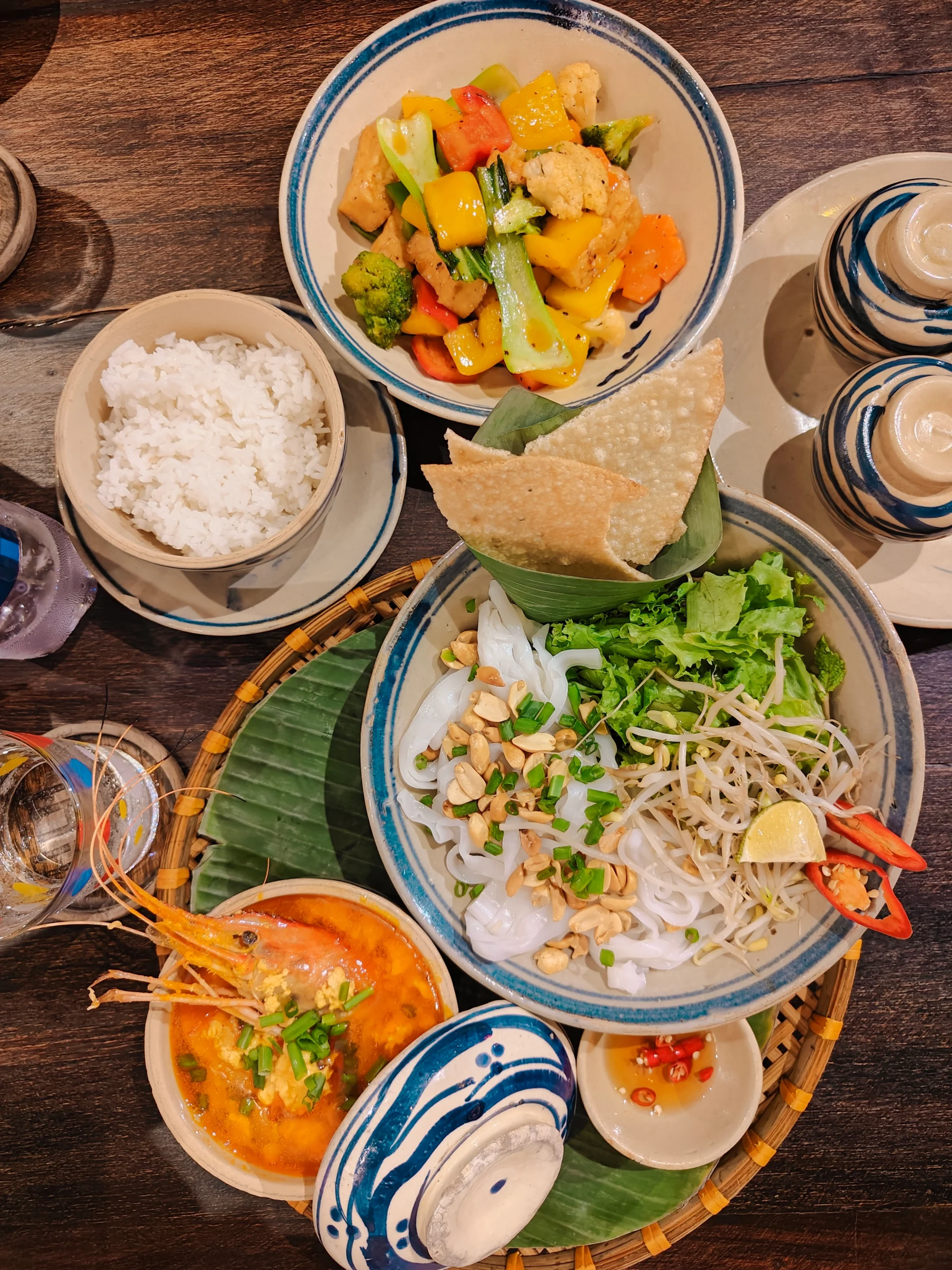
Afternoon: Explore and Shop
This afternoon, you can either sit and chill at a cafe or just walk around the old town and shop till you drop!
- Shopping for souvenirs: The town is filled with shops selling lanterns, handicrafts, and artwork.
- Custom-made clothing: Hoi An is famous for its tailoring. You can get suits, dresses, or traditional ao dai made in just a couple of days.
- Relaxing at the beach: If you prefer a quieter afternoon, head to An Bang Beach for some sun and sea.
Evening: Dinner and Nighttime Stroll
In the evening, regroup for dinner at one of Hoi An’s riverside restaurants. The atmosphere here is magical at night, with lanterns glowing and reflections dancing on the water. After dinner, take a leisurely walk through the lantern-lit streets. If you enjoy music, stop by one of the local cafés or bars that often host live performances. The blend of music, lanterns, and the soft hum of the river makes the night in Hoi An unforgettable.
Day 6: Full-Day Trip to Ba Na Hills
This day is all about exploring the whimsical side of Vietnam at Ba Na Hills, one of the country’s most unique attractions. Located about an hour’s drive from Hoi An (or just 45 minutes from Da Nang), Ba Na Hills is perched high in the Truong Son mountain range, offering a blend of breathtaking natural beauty and man-made charm.
Morning: Cable Car Ride and Golden Bridge
The day begins with a ride on one of the world’s longest cable cars, an experience that is every bit as thrilling as it sounds. Suspended high above the jungle, the cable car glides past waterfalls, rolling hills, and misty peaks. This was easily my favourite part of the day as the journey felt magical, as though you were floating through the clouds.
Once you reach the top, make your way to the Golden Bridge, Ba Na Hills’ most famous landmark. The bridge, held up by two massive stone hands, looks like something straight out of a fantasy movie. It is one of the most photographed spots in Vietnam, and for good reason. However, it does get very crowded later in the day. If you want those picture-perfect, Instagram-worthy shots, the best idea is to head straight here early in the morning before the tour groups arrive.
Nearby, you will also find a serene pagoda, tucked among the gardens. The peaceful setting, with statues and fluttering prayer flags, offers a quiet escape from the busier parts of the hilltop. This was another highlight for me. Standing there, surrounded by mist and silence, felt like stepping into a different world.
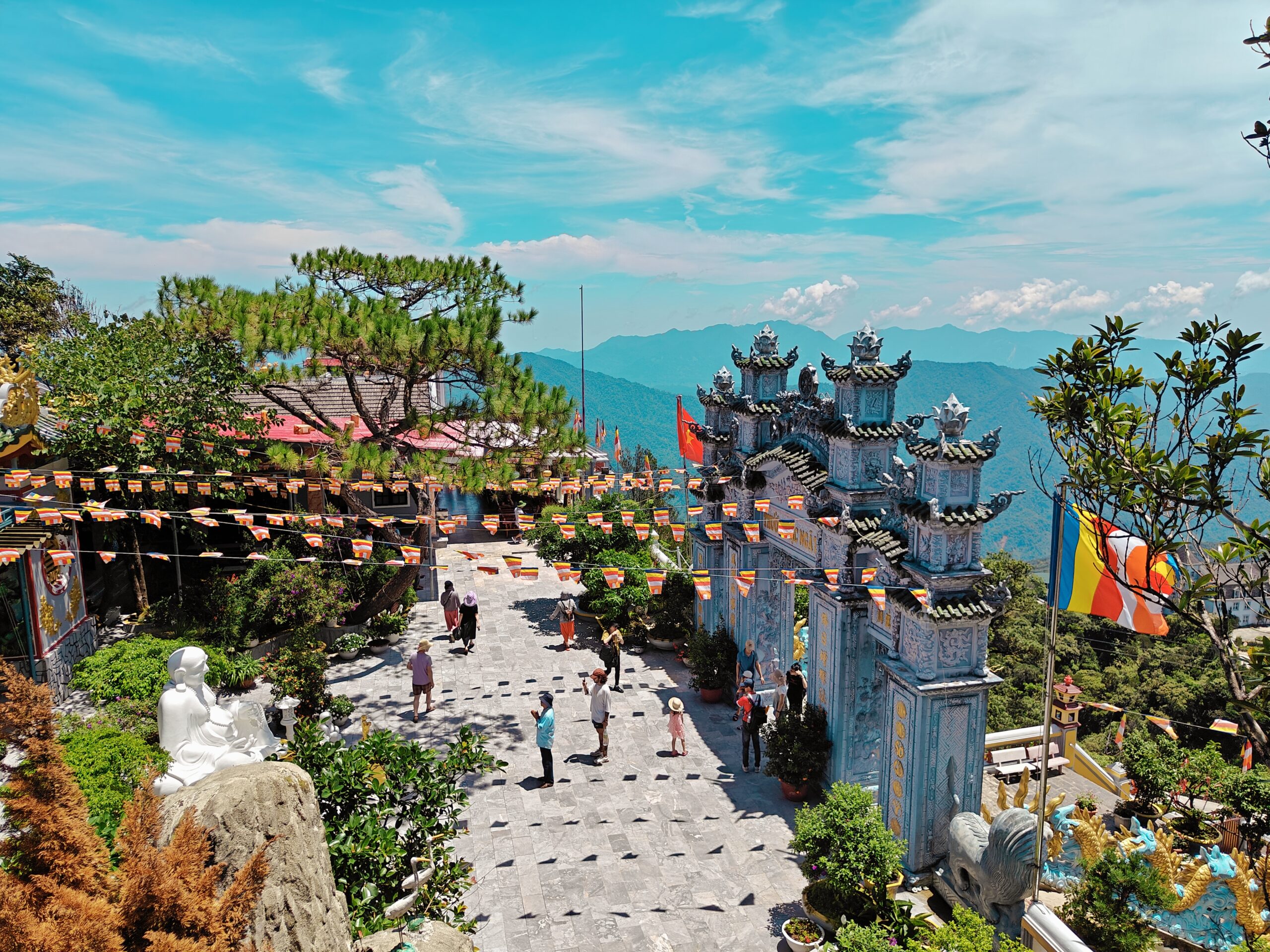
Afternoon: Exploring French Village and Fantasy Park
After soaking in the views, continue to the French Village, a replica of a European town complete with cobbled streets, gothic-style cathedrals, and quaint little squares. It feels slightly surreal to be in central Vietnam and suddenly find yourself surrounded by architecture that looks straight out of France.
For families or those seeking a bit of fun, the Fantasy Park amusement area is well worth exploring. With arcade games, 3D rides, and a quirky underground vibe, it adds a playful twist to the day.
Between sightseeing, take a break to enjoy lunch at one of the restaurants on the hill. Most serve buffet-style meals that combine Vietnamese and international dishes, perfect for recharging before continuing your exploration.
Evening: Return to Hoi An or Da Nang
As the day winds down, take the cable car back down the mountain, enjoying one last look at the sweeping views. From there, drive back to Hoi An or Da Nang for dinner. Whether you choose to enjoy a quiet riverside meal in Hoi An or explore the vibrant dining scene of Da Nang, it will be the perfect end to a day filled with breathtaking scenery and unique experiences.
Day 7: Explore Da Nang: Marble Mountains & Lady Buddha
Day 7 is all about discovering the spiritual and cultural side of Da Nang, a city that beautifully balances natural wonders, religious landmarks, and modern charm.
Morning: Marble Mountains
Start your day with a visit to the Marble Mountains, a cluster of five limestone and marble hills named after the five elements: metal, wood, water, fire, and earth. The mountains are dotted with ancient Buddhist sanctuaries, hidden caves, and shrines that have been places of worship for centuries.
Climbing up the steps might take some effort, but the views from the top are worth it. From here, you can see sweeping vistas of Da Nang’s coastline, lush countryside, and the South China Sea stretching into the horizon. The caves inside the mountains are equally fascinating. Huyen Khong Cave, with its shafts of sunlight streaming through the roof, feels almost mystical.
Take your time exploring, as each mountain has something unique to offer, from pagodas carved into rock to quiet meditation spots tucked away in corners.
Afternoon: Linh Ung Pagoda & Lady Buddha
After the Marble Mountains, make your way to Linh Ung Pagoda, located on the Son Tra Peninsula. The star of this site is the Lady Buddha statue, which stands 67 meters tall and overlooks the sea. It is the tallest Buddha statue in Vietnam, and you can see it from almost anywhere in Da Nang.
The statue is said to protect fishermen and locals from storms, and the atmosphere around the pagoda is deeply serene. Walking through the courtyards lined with bonsai trees and statues of arhats feels calming, and the views of Da Nang’s coastline from here are simply stunning.
This was one of the places that really stayed with me. It is not just about the grandeur of the Lady Buddha but also the peaceful energy of the whole setting.

Evening: Da Nang by Night
As the sun sets, head back into the city to see Da Nang at night. The city is known for its brightly lit bridges, and the most famous one is the Dragon Bridge, which breathes fire and water on weekend evenings. It is a spectacle you should not miss if you are there at the right time.
Afterwards, you can enjoy a relaxed evening strolling along the Han River, do some shopping at local markets or malls, and end the day with dinner at a riverside restaurant. Da Nang’s food scene is vibrant, with everything from fresh seafood to local specialities like mi quang and banh xeo.
Day 8: Departure from Da Nang
Your final day in Vietnam is more relaxed and flexible, depending on your flight schedule.
Morning: A Slow Start
Begin the day with a leisurely breakfast at your hotel or a nearby café. If you are in Hoi An, this could be your last chance to enjoy a strong Vietnamese coffee by the riverside while watching the town slowly come to life. If you are staying in Da Nang, you could squeeze in a beachside breakfast with fresh fruit juice and a view of the ocean.
Last-Minute Shopping and Exploring
If time allows, use these last few hours for some final shopping. Hoi An is famous for its tailor shops and leather goods, so you might want to pick up that custom-made outfit or a pair of handcrafted sandals. Da Nang, on the other hand, has modern malls and local markets like Han Market, where you can find souvenirs such as dried fruits, coffee beans, handicrafts, and conical hats.
A short stroll along the Han River or a quick stop at a local pagoda can also be a peaceful way to bid farewell to Vietnam before your flight.
Airport Transfer
You can head to Da Nang International Airport for your departure flight. The airport is well-connected and easy to navigate, with both domestic and international flights operating daily. Make sure to arrive at least two hours before your flight if you are flying internationally.
Final Tips for 8 Days in Vietnam
Before wrapping up your trip, here are a few practical tips that can make your 8 days in Vietnam smoother and more enjoyable:
Best time to visit: The ideal time is during spring (March to April) and autumn (September to November). These seasons offer pleasant temperatures, less rainfall, and clear skies, making it easier to enjoy both cities and nature.
Transport within Vietnam: Domestic flights are the fastest way to cover long distances, such as Hanoi to Da Nang. Trains and buses are budget-friendly options if you want to experience the journey at a slower pace. Grab (the local ride-hailing app) is convenient for short city rides.
Currency: Vietnam uses the Vietnamese Dong (VND). While credit cards are accepted in hotels, upscale restaurants, and shops, cash is essential for street food, local markets, and smaller towns. ATMs are widely available in cities.
Must-try food: Vietnam is a paradise for food lovers. Do not miss pho and bun cha in Hanoi, cao lau in Hoi An, mi quang in Da Nang, and the globally loved banh mi. Street food stalls often serve some of the most authentic flavours at very affordable prices.
Packing tip: Carry light cotton clothes, comfortable walking shoes, sunscreen, and insect repellent. A light jacket might be useful in the evenings or if you plan to visit northern Vietnam in the cooler months.
Cultural etiquette: When visiting temples or pagodas, dress modestly and remove your shoes before entering prayer halls. A small gesture of respect goes a long way.
[Also Read: A First Time Traveller’s Guide to Vietnam]
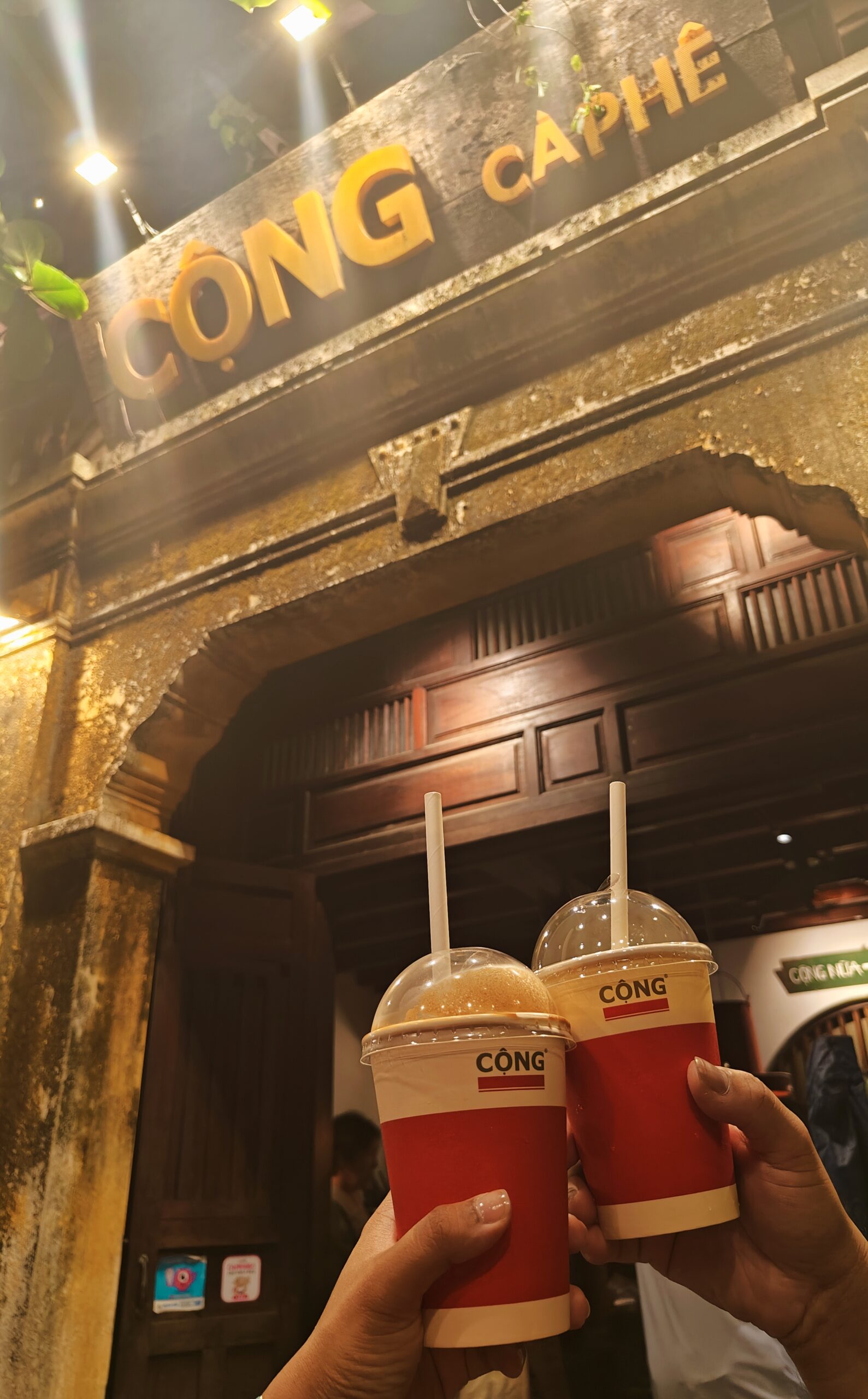
Vietnam is truly one of my favourite destinations to travel to. Every time I return, I discover something new – whether it is sipping coffee in a quiet corner of Hoi An, kayaking through the limestone cliffs of Ha Long Bay, or watching lanterns float down the river at night. The country has a way of blending history, culture, food, and natural beauty into an experience that stays with you long after you leave.
If you are planning an 8-day trip to Vietnam, this itinerary will give you the perfect balance of iconic highlights and hidden gems. From Hanoi’s bustling Old Quarter to Da Nang’s dramatic landscapes and the timeless charm of Hoi An, it is a journey you will remember for a lifetime.
I have been to Vietnam multiple times, and it is a place I never get tired of exploring. If you are thinking of planning a trip and need some help with routes, must-sees, or even food recommendations, feel free to drop a comment below. I would love to help you craft your own unforgettable Vietnam adventure.
Disclaimer: This post contains a few affiliate links. If you happen to click on any of them and make a purchase, I might earn a small commission, at no extra cost to you. Just know that I truly appreciate your support if you choose to do so.



